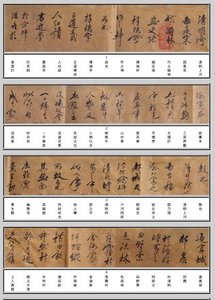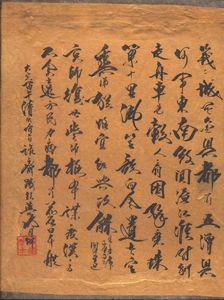清明上河圖
Along the River During
the Qingming Festival
The present scroll is a reproduction of the fairly faithful copy made by Zhao Mengfu (趙孟頫 1254–1322). It differs slightly from the original. It is preceded by the title in seal script and the inscription "Hanlin imperial academy member Zhao Mengfu" (翰林學士 趙孟頫), there is a running text above, and a colophon at the end. The size, including the text above and at both ends, is 28x390 cm. Compared to the original, the perspective on this copy is indeed squeezed horizontally. It is painted on silk glued on paper or parchment, yellowed with age, clumsily cut around the edges and folded concertina-style within two silk-covered rigid covers. It was bought in Chengdu in 2006.
Click on the images below to access the painting, the text above it and the colophon.
|
|
|
One reason why there are so many copies of the Zhao Mengfu painting
available, even though it might no longer exist, is that Suzhou (near
Shanghai) had a tradition of copying or forging famous paintings for a
living, starting during the reign of emperor Wanli (1563-1620), until
the end of the Qing dynasty. Copies of some paintings then spread to
all parts of China.
(Information retrieved from Guāngxù yuánbǎo on June 7, 2017)
A rather different (and much longer) version of the Qingming Festival scroll was produced in 1737 at the request of the Qianlong emperor. The 11-meter scroll is shown on the same Wikipedia page as the original. In 1751, the Qianlong emperor commissioned another painting in the same style depicting life in Suzhou. This 12-meter long scroll, entitled 姑蘇繁華圖 (Gūsū Fánhuá Tú, Prosperous Suzhou) is described in this Wikipedia page.



